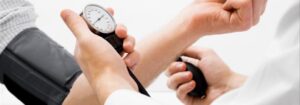 Most of us know we don’t want our blood pressure to be “high.” But what does that actually mean? Do you know what numbers are ideal and what they refer to? Here is a quick breakdown of what you need to know about your blood pressure and the numbers.
Most of us know we don’t want our blood pressure to be “high.” But what does that actually mean? Do you know what numbers are ideal and what they refer to? Here is a quick breakdown of what you need to know about your blood pressure and the numbers.
Blood pressure is the force of blood against the walls of the artery. It is written in two numbers. The first number is the systolic pressure. It is the measure of pressure in the arteries when the heart beats and pushes blood into the arteries. The second number, called the diastolic pressure, is the pressure in the arteries when the heart rests between beats. The brachial artery is the artery used to measure your blood pressure. It’s the blood vessel traveling from your shoulder to below your elbow.
Hypertension is high blood pressure (usually greater than 140/90). Hypotension is low blood pressure.
The chart below provides some insight into what blood pressure readings mean. Always consult your doctor about any readings you think might be abnormal. Only your doctor can diagnose high blood pressure or any other possible condition that may affect your blood pressure.
| Systolic pressure (first number) |
Diastolic pressure (second number) |
|
| Normal | Less than 120 | Less than 80 |
| Prehypertension | 120-139 | 80-89 |
| High Blood Pressure: Stage 1 | 140-159 | 90-99 |
| High Blood Pressure: Stage 2 | 160 or Higher | 100 or Higher |
Ideally, you want your blood pressure to be less than 120/80. A reading less than 120/80 indicates your blood vessels are supple and healthy. When your arteries get clogged with plaque, they are unable to expand adequately, and the pressure inside the walls builds up. Higher blood pressure can sometimes indicate the beginning of cardiovascular issues. The good news is there are natural ways to lower your blood pressure. Diet, exercise, and stress management can reduce your blood pressure numbers over time.
Here are some tips on how to get an accurate measure of your blood pressure:
- For starters, wait 30 minutes after eating or consuming caffeine, alcohol, or tobacco before checking your blood pressure.
- Empty your bladder.
- Rest for 3 to 5 minutes, and don’t talk.
- Sit in a comfortable position, do not cross your legs or ankles, and make sure your back is supported.
- Elevate your left arm, so it’s in line with your heart. Resting it on a table usually is sufficient.
- Place the cuff around the upper part of your arm. Make sure the cuff is smooth and snug, leaving just enough room to slip one finger under it.
- Don’t forget to sit still.